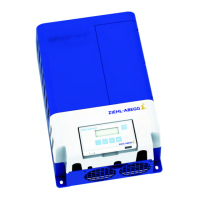
Do you have a question about the ZIEHL-ABEGG ZETADYN 4C and is the answer not in the manual?
| Category | DC Drives |
|---|---|
| Type | ZETADYN 4C |
| Output Current | 4 A |
| Protection Class | IP20 |
| Operating Temperature | 0°C to +40°C |
| Storage Temperature | -20°C to +70°C |
| Output Voltage | 0 to 400 V DC |
| Efficiency | >95% |
Outlines qualifications and responsibilities for personnel working with the device.
Safety precautions during the commissioning of the device.
Warns about hazards from residual voltage and safety measures.
Defines the operator's responsibilities for safe installation and operation.
Details how to install the inverter to comply with EMC standards for lifts.
Outlines points to observe when switching and wiring STO signals for safety.
Provides safety warnings and instructions for connecting the mains supply.
Details requirements for motor connection, including cable cross-section, type, and length.
Emphasizes the necessity of connecting a temperature monitor when using a brake resistor.
Guides on adjusting initial parameters like language, user level, and motor type.
Provides a step-by-step guide for testing the STO safety function.
Advises on performing the first test run safely, considering motor type and calibration.
Guides on optimizing speed controller settings (SPD_KP) for smooth startup and drive behavior.
Introduces the STO function as a safety stop in accordance with DIN EN 61800-5-2.
Explains the two-channel safety input structure and internal diagnostics for STO.
Provides important operational notes regarding STO signal timing and error handling.
Lists parameters required for first-time start-up, including language and motor data.
Details parameters for entering motor data from the name plate for proper operation.
Covers parameters for rotary encoder type, resolution, and brake resistor/chopper type.
Lists parameters for entering installation-specific data like rated speed and suspension type.
Details parameters for configuring the elevator control system, digital inputs, and outputs.
Lists parameters for optimizing startup behavior, including control actions and timing.
Explains parameters influencing speed control, like basic amplification (SPD_KP).
Contains parameter values for aligning absolute value encoders for synchronous motors.
Details configuration data for the "Safety gear" function, including safety brake settings.
Details the required input signals and the start-up procedure with acceleration.
Provides information and steps for optimizing startup behavior to improve travel comfort.
Explains path-dependent deceleration and its activation criteria.
Explains time-dependent deceleration activated when S_ABH is OFF.
Explains direct leveling, possible with DCP2/DCP4, CANopen Lift, and absolute shaft copy system.
Describes fast-start where motor energizes on cabin door close and brake opens for immediate travel.
Details monitoring functions for Quickstart to prevent faults related to speed or encoder signals.
Explains emergency evacuation using a single-phase mains supply for synchronous motors.
Outlines prerequisites for parameterization, including direction of travel and voltage drop detection.
Details emergency evacuation using UPS for synchronous motors, specifying load conditions.
Describes characteristics and UPS performance calculation for evacuation with optimum power.
Explains evacuation with minimum UPS power, noting load-dependent positioning.
Guides on parameterizing evacuation type, stator resistor, and motor current limits for UPS.
Explains emergency evacuation by manually or electrically opening motor brakes.
Describes the monitor function for evacuation direction and speed, activated by a digital input.
Explains travel abort procedures and output states upon detecting an error.
Guides on accessing and interpreting the fault list saved in the Statistic menu.
Provides a detailed list of error messages, their causes, and remedies.
Lists hardware and software errors, their causes, and remedies.
Details configuration errors, motor type selection issues, and input/output assignments.
Lists errors occurring before trip start, including motor/processor errors and ADC calibration issues.
Lists errors related to aborting travel for protection, including voltage and temperature monitoring.
Covers errors related to trip aborts for installation protection, including speed and STO monitoring.
Lists errors related to communication issues between ZETADYN 4 and control via DCP.
Lists errors occurring during CANopen Lift operation, including timeouts and status issues.
Details fatal errors requiring switching off the ZETADYN 4, including hardware/software errors and UPS issues.
Lists common startup problems and their adjustments, such as ZETADYN not starting or motor not reaching speed.
Describes the PFU for feeding generated energy back into the network and achieving energy efficiency class A.
Highlights the necessity of rotary encoder calibration for synchronous motors.
Details the procedure for load-free alignment of SSI encoders, including offset calibration.
Explains load-free alignment for EnDat encoders, including offset saving and double calibration.
Describes the process for checking the load-free alignment of SSI and EnDat encoders.
Details calibrating the rotary encoder with the brake closed for easier cable handling.
Explains the alignment of absolute encoders of type ERN1387 with the brake closed.
Explains the safety brake function for releasing the car from the safety gear.
Guides on performing software updates using a memory card.
Explains checking motor phases during the start procedure to avoid undefined activities.
Explains operating the motor without an encoder, including restrictions and activation.
Explains implementing controlled emergency stops in inclined elevators to prevent passenger injury.
Explains self-monitoring of brakes using micro-switches for protection against unintended car movement.
Guides on activating self-monitoring by selecting brake circuits and micro-switch function.
Details the function test procedure for self-monitoring of brakes according to EN81-1.
Covers support for acceptance tests, including rotary encoder and motor temperature tests.
Details testing protection devices according to EN81-A3 to prevent accidental cabin movement.